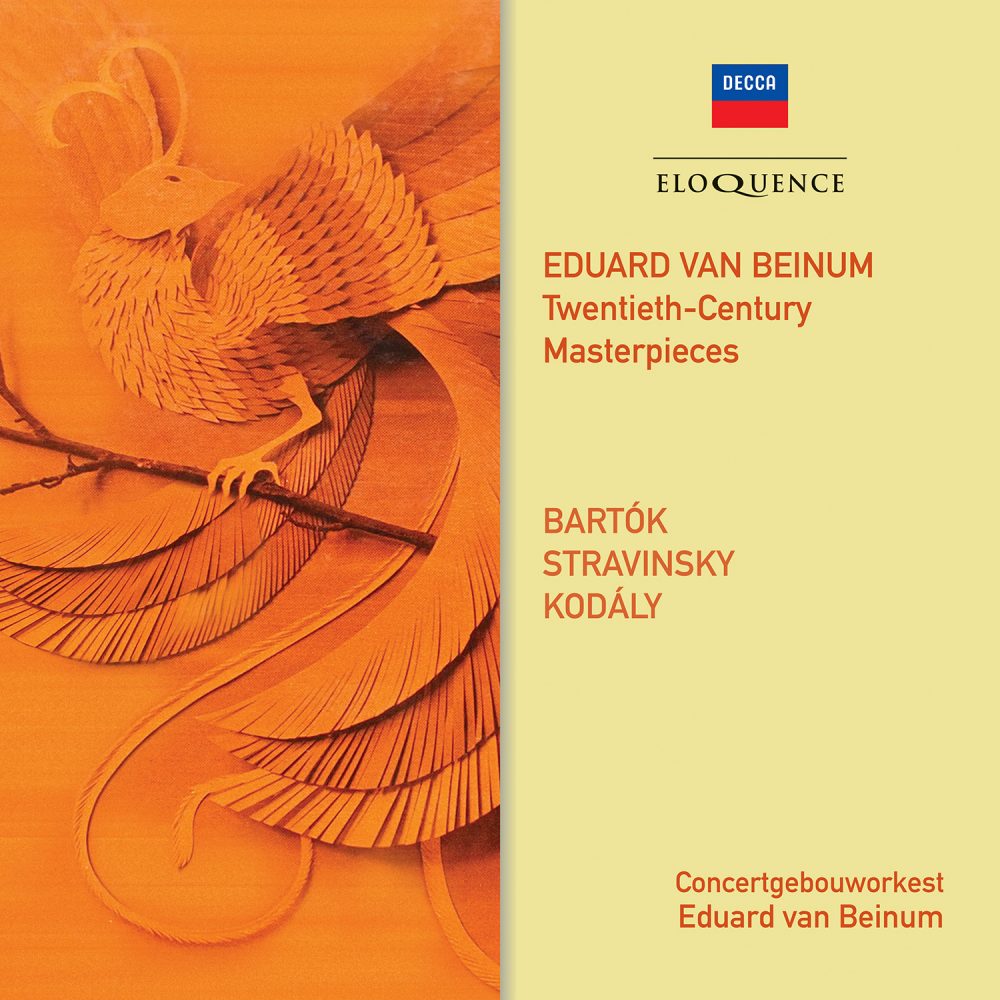The recorded legacy of Eduard van Beinum has been extensively documented on Eloquence. Previous issues have revealed the Dutch conductor’s mastery of and sympathy for 20th-century composers such as Sibelius (442 9487) and Britten (480 2337). His clear-headed approach to any score, combined with the refinement of the Concertgebouw Orchestra, particularly suit the music of Bartók and Stravinsky represented here. At the same time, Van Beinum was renowned for a fastidious ear in the matter of orchestral colour – he could draw out a full palette of sonority in works such as the ‘Symphonie fantastique’ of Berlioz (also on Eloquence, 4825569) and Rimsky-Korsakov’s’ Scheherazade’ (4825511), a palette which is further tinted and enhanced by the twanging cimbalom in the uproarious suite from Kodály’s ‘Háry János’ to conclude this album.
In the repertoire of Willem Mengelberg, Van Beinum’s predecessor at the Concertgebouw, the enthusiasm for music of his own time did not extend much beyond that of his friend Gustav Mahler and native fellow-Dutch composers. It fell to the younger man when he finally took full charge of the orchestra in 1945 after sharing responsibility with Mengelberg for several years, to update its repertoire. He did this by casting his net across European modernism and its most distinctive voices. Folksong, whether real or invented, was central to the different idioms of the three composers here, from Stravinsky’s use of old Russian tunes in his sensational first commission for the Ballets Russes of Serge Diaghilev, ‘The Firebird’ of 1910 (Van Beinum conducts the suite made in 1919) to the unmistakably ‘Hungarian’ sound of both ‘Háry János’ (1926) and Bartok’s late Concerto for Orchestra of 1943.
The most adventurous music here may not even be heard in the archaic savagery of ‘The Rite of Spring’ (a recording that set new standards for precision in this complex score when first issued in 1948, still on 78s) but in the 1956 recording of another suite, extracted by from his magical, mechanical opera of 1914, Le Ross’ignol’ (The Nightingale).
CD 1
BÉLA BARTÓK
Concerto for Orchestra, Sz. 116
Music for Strings, Percussion and Celesta, Sz.106*
IGOR STRAVINSKY
L’Oiseau de feu: Suite (1919 version)*
CD 2
IGOR STRAVINSKY
Le Sacre du printemps
Le Chant du Rossignol – Poème symphonique*
ZOLTÁN KODÁLY
Háry János: Suite*
Concertgebouworkest
Eduard van Beinum
*FIRST CD RELEASE ON DECCA
Recording Producers: Victor Olof (Concerto for Orchestra, Le Sacre du Printemps); Jaap van Ginneken (Music for Strings, Percussion and Celesta, L’Oiseau de feu, Le Chant du rossignol, Háry János)
Balance Engineers: Kenneth Wilkinson (Concerto for Orchestra, Le Sacre du Printemps); Henk Jansen, Hans Lauterslager (Music for Strings, Percussion and Celesta); Henk Jansen, Bruno Taschner (L’Oiseau de feu, Háry János); Henk Jansen, Cees Huizinga (Le Chant du rossignol)
Recording Location: Concertgebouw, Amsterdam, The Netherlands, 11 September 1946 (Le Sacre du printemps), 15 & 22 September 1948 (Concerto for Orchestra), 11–12 April 1956 (Háry János), 13–14 October 1955 (Music for Strings, Percussion and Celesta), 6 April 1956 (L’Oiseau de feu), 22 May 1956 (Le Chant du rossignol)
Remastering Engineer: Chris Bernauer
Original LP Releases: Decca LXT 2529 (Concerto for Orchestra – first released as AK2042-46 in January 1949); Decca (A)K1727-30 (Le Sacre du printemps – 78-rpm release only, in March 1948); Philips A00353L (Music for Strings, Percussion and Celesta, Háry János Suite); Philips S06130R (Le Chant du rossignol; L’Oiseau de feu)
‘An uncommonly sound performance and a truly brilliant recording, bringing out more of the score than I should have thought possible.’ Gramophone, March 1948 (Le Sacre du printemps)
‘A triumph of engineering and conducting. In no other version will be the cimbalom sound as clear.’ Gramophone, January 1957 (Háry János)
‘[Van Beinum] takes a thoroughly Romantic view of this music, giving a performance that emphasises its links with the Rimsky of ‘Coq d’Or’ and ‘Scheherazad’e … the beautiful playing of the Concertgebouw woodwind, and the recorded tone is warm to match.’ Gramophone, March 1958
(Le Chant du rossignol, L’Oiseau de feu)

